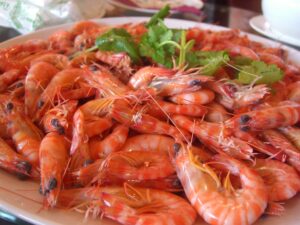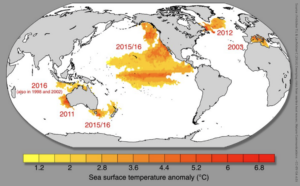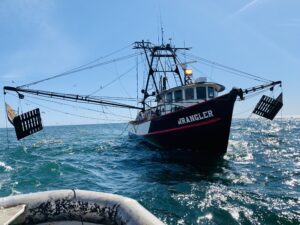Reviewing: Shalders, T. C., Champion, C., Coleman, M. A., Butcherine, P., Broadhurst, M. K., Mead, B., & Benkendorff, K. (2023). Impacts of seasonal temperatures, ocean warming and marine heatwaves on the nutritional quality of eastern school prawns (Metapenaeus macleayi). Science of the Total Environment, 876, 162778.

What comes into your mind when you think of the impacts of climate change? Increasing global temperatures? Rising sea levels and melting glaciers? More floods and droughts? Animals and plants facing higher risk of extinction? These are all serious consequences of climate change that affect different aspects of our lives. But did you realize that climate change may also affect the nutritional quality of food?
Seafood has many nutritional benefits, because it is packed full of important nutrients like essential fatty acids, proteins, lipids, vitamins and minerals that are essential for our health. As global population increases, humans will likely rely more and more on seafood. But according to a team of researchers, climate change can decrease the nutritional quality of seafood.
The researchers wanted to find out how future warming of our oceans may affect the nutritional quality of eastern school prawns. Every year, over 1000 tons of eastern school prawns are caught in fisheries to be brought to our tables directly or to be used as baits for larger fish. For their experiments, the researchers collected 550 eastern school prawns from the Clarence River at Australia, then randomly divided them into groups and put them into 15-L “ocean” tanks with seawater and 20mm of beach sand. After the prawns got used to the “ocean” tanks for a week, the researchers slowly ramped up the water temperature in some of the tanks over two days. More specifically, to simulate summer conditions, the tanks were divided into 4 groups. The first group of seawater tanks were kept at the average annual summer temperature (24°C), while the second and third group of tanks used water at maximum summer temperature (27°C), or “future” maximum summer temperature (29°C). The fourth group of tanks simulated a “heatwave” event, by holding the seawater temperature at 27°C for 7 days, then increasing it to 29°C for 6 days, and decreasing it back to 27°C. After 28 days and 56 days, the researchers randomly selected some prawns out of each tank group and measure the body compositions of those prawns (called “proximate composition”, which includes protein, moisture, ash, and lipid content), as well as several toxic elements in the prawns’ bodies.

The researchers found that there was no significant change on the prawns’ proximate and fatty acid composition after 28 days of exposure to higher temperatures. This could mean that these prawns were handling the short-term temperature increase well and adapting quickly to their new environment. However, prawns that lived at higher temperatures for 56 days did not do as well. Prawns under heatwave conditions had much higher amounts of arsenic and cadmium in their bodies. Both arsenic and cadmium are toxic elements, but because they still exist naturally in the environment, prawns can usually detoxify these elements and keep them at low levels in their bodies. But in this case, warmer temperatures may have negatively affected the prawns’ ability to detoxify arsenic and cadmium effectively. Prawns exposed to warmer temperatures also had much lower amounts of fatty acids like omega-3 and linoleic acid in their bodies. These fatty acids are essential in our diet, because even though our bodies are pretty efficient at making various fats they need from scratch, they cannot make these fatty acids in particular that keep our hearts and brains healthy – so we must get these fatty acids from food.

The researchers also observed that 60-70% of prawns living in high temperature tanks died by the end of their 56-day experiment. This means that future warming ocean temperature could cause huge declines in prawn populations, which would in turn reduce the amount of prawn we can use as food. This also means that fisheries may not be able to keep up with sustainable fishing practices. Of course, it may be too early to worry about the future of seafood, considering that this study only observed the effect of higher seawater temperature on one species of prawn, and the mortality and nutritional quality of eastern school prawns may also change over longer periods of time. But studies like this are still important because they can raise our awareness on different aspects of climate change and can better prepare the fisheries and seafood consumers for the future.
I am a PhD student in chemical oceanography at University of Washington. I am studying how different forms of metals in the ocean are shaping microbial communities in the North Pacific Ocean. When not working, I like going for a walk, visiting farmers’ markets and playing keyboard.

